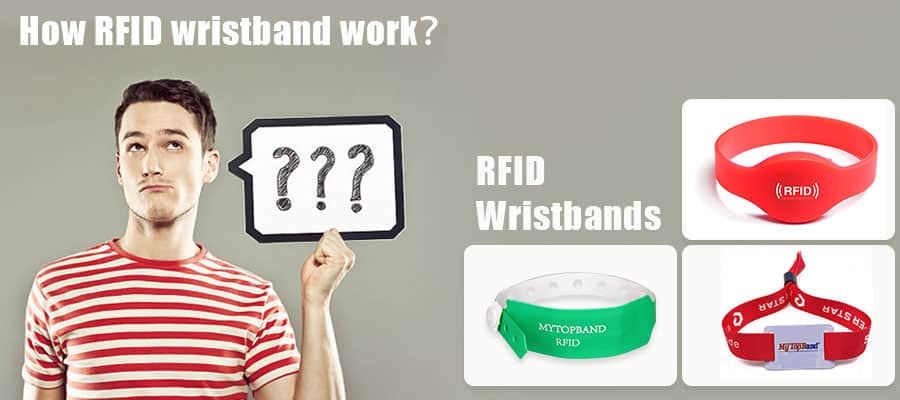
When you see this article, believe you have already known or prepared to know the RFID Wristbands. You may have seen or used RFID Wristbands on many occasions, such as water parks, theme parks, hotels, music festivals, food festivals, etc. These wristbands appear in different occasions with different designs and materials. If you are interested in knowing more about RFID Wristbands, please must read this article.
What’s RFID tech?
RFID is the abbreviation of Radio Frequency Identification, it’s a kind of automatic recognition technology. RFID uses wireless radio frequency to conduct contact-less bidirectional data communication, use wireless radio frequency to read and write the medium (Smart Card, Tag, Wristbands) to achieve the purpose of identifying targets and data exchange.
RFID tech can be divided into three categories based on the power supply method of its tags:
- Passive – Passive RFID tags do not have a battery built-in and they utilize radio energy transmitted by the reader for power.
- Active – There is an onboard battery that powers the RFID tag, which transmits information regularly without requiring a reader.
- Battery-Assisted – The RFID tag contains a battery that only powers the tag when in the presence of a reader.
Among the three types of RFID radio frequency technology, the passive RFID has the earliest time, the most mature, and the most widely used. Because the power supply system is eliminated, the volume of the passive RFID products can reach the order of centimeters or even smaller, and its own structure is simple, the cost is low, the failure rate is low, and the service life is longer. Therefore, MyTopband’s RFID Wristbands are based on passive tag technology.
Passive tag wristband Three frequency and work distance:
Low Frequency (125-134 kHz) :
Very short read/write range of no more than a few centimeters, with limited memory storage capacity. Low data transmission speeds and few tags can be read at once.
High Frequency (13.56 MHz) :
Short read/write range of several inches, but with larger memory capacities and medium data transfer rates.
Ultra-High Frequency (433 MHz & 856-960 MHz) :
Long distance read/write range of up to 70 feet and large data capacities. High data transfer rates as well.
When it comes to RFID wristband systems at parks and festivals, most operate at high frequency with passive tags. A low power radio wave activates the tag to read and write data that is used to identify a guest.
How RFID Wristbands work in RFID systems?
The complete RFID Wristbands system is composed of three parts:
- Reader, RFID Wristbands, and data management software.
- RFID Wristbands has a short -term power supply by receiving the microwave signal transmitted by the reader and obtaining energy through the electromagnetic induction coil, so as to complete the information exchange.
- When read (or ‘tapped’), an RFID scanner will transmit an encoded radio signal which identifies a tag. In less than a millisecond, RFID tags receive the transmission and respond with a unique identification number.
How Much Data Can an RFID Wristbands Store?
An important element in how RFID Wristbands work is storage capacity. The largest passive RFID tags can store up to 3720 bytes, or 3.72 kilobytes of information. That may seem like a small amount, but that is enough to store your name, address, credit card numbers, date of birth, and whatever identifying information the local administrator wants to track.
So when you walk through a checkpoint, you can choose to have your activity or photos posted to social media automatically.
For access control systems, RFID tags are usually 3 kilobytes or smaller.
In RFID Wristbands products, customers usually use NXP MiFARE Classic 1K chips, or Ultralight EV1/C series chips. Different chips have different storage space. The customer’s system determines what chip is used in the wristband.
What parts of an RFID Wristbands?
An RFID Wristbands contains a ‘smart tag’ made up of an RFID chip and antenna. The tag can be in the form of a visible card (often made from plastic for durability) or it can be hidden or ’embedded’ in other wristband materials like silicone and cloth.

According to the RFID Wristbands application environment, RFID Wristbands roughly has the following Styles:
- RFID Fabric/Cloth wristbands: Eco RPET or normal Polyester band + RFID slider+Lock;
- RFID Silicone wristbands: Eco-silicone band+Built-in RFID chip
- RFID stretch wristbands: Elastic stretch band + Built-in RFID chip
- RFID Plastic wristbands: Eco-plastic band+built-in RFID chip
- RFID thermal wristbands: Printable thermal band + built-in RFID chip
- RFID Tyvek paper wristbands: Tyvek paper band+surface attached RFID inlay
Mytopband provide more material wristband customized service.
How to select a correct RFID Wristbands?
If your application scenario is Cashless music festival, Food&drink festival, sport games, Forum, outdoor party etc, RFID fabric wristbands, Tyvek wristbands and stretch wristband would your best option. This wristbands support full color print, and support both of disposable or reuse lock, most important is fabric wristband with better price than other material.
If your application scenario is Water park, theme pack, hotel, beach park, Zoo park etc. We recommend RFID silicone wristband, thermal wristband and plastic wristband for you. Because this wristbands with very good waterproof performance, besides, this RFID wristbands also support customized logo print. Compare with Fabric wristband, this wristbands have longer cycle life.
The benefits of RFID Wristbands Technology for Events:
High Anti-counterfeiting performance: RFID Wristbands has the only ID number in the world, password input protection, and the data part can be used to implement security management with encryption algorithms.
Efficient management:
RFID Wristbands can record the entrance of tickets in and out, time, effectively prevent tickets from being stolen again. According to the needs of security management, set up multiple inductive regions to track and position the person in real time.
Consumption guarantee:
RFID Wristbands can effectively protect consumers’ rights. The audience cannot identify the authenticity of tickets to the naked eye when purchasing tickets. You can send it to the organizer data center through the reader and ID number. The data center will feedback relevant information in real time.
Quick scan:
Compared with the barcode, RFID does not need to be scanned in a straight line. The reading and writing speed is very fast. RFID transmits information with radio waves without the problem of transmitting barrier.
Profitable for event business:
RFID Wristbands are not only helpful for consumers but they are also beneficial for business in terms of revenue generation. RFID events can generate more revenue than regular events that use the cash system for tickets, food, drinks, etc. Research shows that on average, a person makes a 30% higher transaction with a cashless payment system. So, when you host an event where participants have RFID Wristbands, they will feel more secure about their money and tend to spend more on impulse.

RFID technology is very mature and the market is huge. If you are looking for high -quality RFID Wristbands supplier, we are confident to provide you with high -quality services. There are many successful application cases in our wristbands, such as: Riverbend Festival,New York Comic Con exhibition,Bay Dreams festival, Expo Dubai 2020 etc.
Please find us: www.mytopband.com, or send message to info@mytopband.com, we will reply you within 24 hours.
